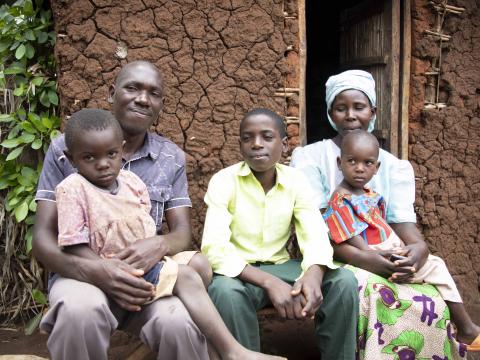Enhancing child sponsorship activities in Busia through the household clustering approach

By Simpson Biryabaho & Racheal Auma
The Household Engagement and Accountability Approach is a World Vision community empowerment approach that brings together 10 to 15 households in a community with a view to increasing household participation in ensuring child well-being. The approach cuts across all other sectors of World Vision's work such as health, education, livelihoods and child protection at the household level.
In Busia, the approach was rolled out in 2018 in Ngochi Village, Busitema sub-county and was applauded by the sub-county leadership as a self-sustaining approach. Currently, Busitema Area Programme (AP) has 120 active household clusters while Lunyo has 180. For proper functionality of the approach, there is need for continuous monitoring and guidance of formed clusters; which helps to measure their progress.
World Vision relies on Community Volunteers (COVA) to mobilise children within the shortest possible time for sponsorship activities like writing Annual Progress Reports (APR), Christmas cards, capturing child update photos, videos and sponsor spontaneous letters, among others. Busitema AP has a total of 3,086 children registered under World Vision's sponsorship programme, of which 1,716 are sponsored. In order to further enable children to meaningfully participate in sponsorship processes, Centralised Child Participation and Development Centres (CDPCs) were established for this and for children to have an area to play and interact.
Volunteers face challenges such as moving long distances to children’s homes, lack of transport means for caregivers when bringing the children to the CDPCs, and late arrivals by children, which affects the time of completion of the sponsorship activities.
Forty-two-year-old Rose Nasirumbi, a Community Volunteer in Ngochi Village in Busitema, shares that whenever she was called upon to mobilise children for sponsorship activities, she moved the entire village; a very tedious process that she now no longer has to go through now with the household cluster approach.
Household cluster committees now support the mobilisation of children, which has greatly helped reduce the time children take to arrive for activities. Winnie Itinot, a COVA Coordinator notes the support the clusters gave during a recent exercise: “We succesfully supported all the sponsored children to write spontaneous letters to their sponsors within two weeks and I attribute this to the mobilisation done especially by household cluster leaders and LCIs in our AP,” said Winnie.
“The Government and other institutions should incorporate World Vision’s household cluster approach into their own programmes to ensure that children grow up healthy, are learning and are safe,” says Bernard Buloba, a happy Chairman LC1 of Ngochi village.
“I used to move very long distances while mobilising children and ensuring I meet the timelines. However, now with the household cluster approach, I simply work with the committees to support me in bringing the children together within the shortest time, and then work is also done swiftly.” concludes a happy Rose.